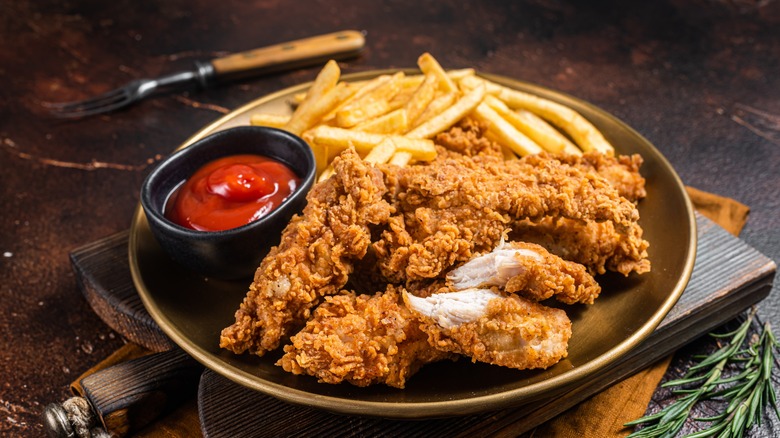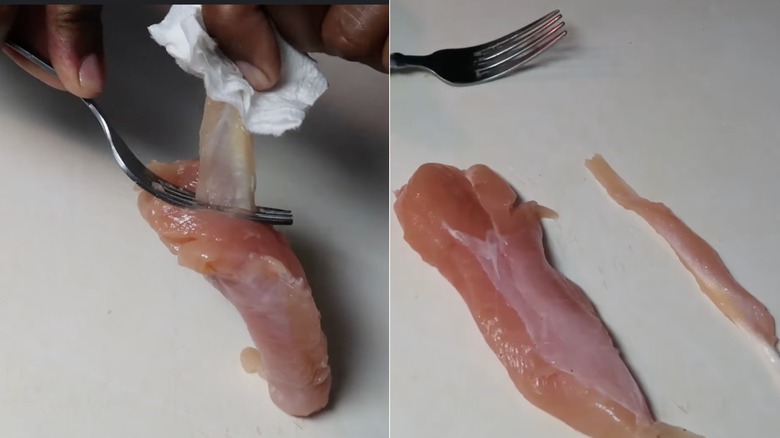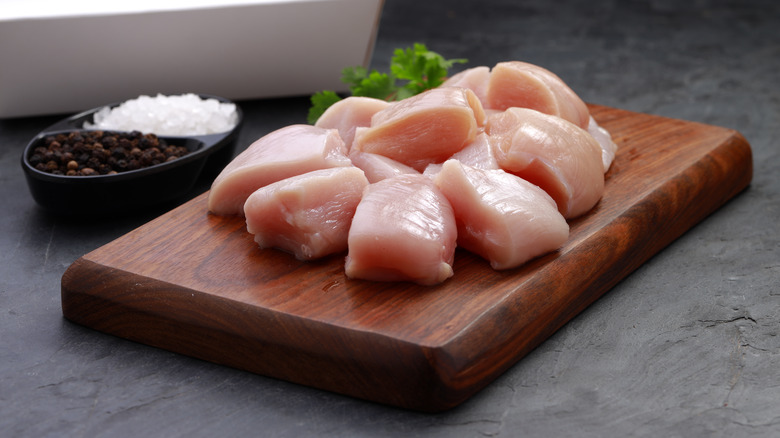The Fork Tine Hack To Prep Better Chicken Tenders
Preparing chicken tenders can be particularly challenging if you're squeamish in the kitchen when handling raw meat. Often seen on the kids' menu, deep-fried and served in a basket with fries (yum), these finger-shaped foods contain a chewy tendon running throughout the white meat, poking out the fatter end like a tail.
While entirely safe to eat, the floppy white tendon can be unsightly to look at when the chicken is raw, and develop a rubbery texture when cooked. It can be removed with a chef's knife and a bit of patience, or with this genius fork tine hack that's gone viral on social media.
@frannielovesfood #chickentenderhack #chickentenders #kitchenhack #hacktok #lifehacks #kitchentips #ShowUsYourDrawers
Part of the appeal of chicken tenders is their small size, but since the tendon runs the length of the meat, removing it can waste a lot of chicken. Viewed over two million times, TikToker @frannielovesfood is one of the hundreds posting a video demonstrating this simple way to remove the tenderloin's tendon for better-tasting chicken — simply hold onto the exposed tendon, slip it through two tines of a fork, and detach it from the meat.
How to prep chicken tenders
Depending on their size, two to three chicken tenders constitute a serving. Multiply that by the number of people you're feeding, and that's a lot of work for such a small piece of protein. Fortunately, this fork tine hack makes quick work of the job.
The tendon is slippery, so you'll need a paper towel to hold it while you work. Hold onto the exposed tendon and slip it through two tines on a fork. Rest the tendon against the root of the fork where the tines attach. This minimizes the amount of meat removed with the tendon, eliminating waste.
Slide the fork along the length of the tender, anchoring the tendon as it detaches from the meat. It helps to rest the side of the fork against a cutting board so the cleaned meat is deposited on the other side of the fork once the tendon is removed. If you notice a lot of meat still attached to the tendon, apply slight pressure against the root so the tendon is clean once removed.
Unlike other chicken parts that can be saved for stock, the tendon can be discarded. Sometimes, the tendon isn't exposed. Use a paring knife to make a slit in the fatter side of the chicken to access enough of the tendon to hold it securely. You may need to scrape along the tendon with the blade to grab it without removing too much meat.
Tips for cooking with chicken tenders
Unfortunately, since there are only two tenderloins per chicken, chicken tenders tend to be more expensive than chicken breasts. While the tender may be attached to the breast when you buy it from the butcher, it is a separate, smaller muscle found below the breast meat when the ribs are removed. Both are lean white meats, but the tenderloin, being less worked, is a more tender cut. This makes them a good choice for people who don't want to eat the fattier (and arguably more delicious) dark meat, but find chicken breasts tough. Still, chicken breasts can be pounded and cut into strips for use in chicken tender recipes.
Since you are paying a premium, it makes sense to cook the tender whole, although it can be cut into bite-sized pieces for additional recipes. While breaded and deep-fried chicken tenders are delicious, there are variations the whole family will love.
Try swapping out traditional breadcrumbs for different crunchy coatings. Crushed potato chips, pretzels, and Fritos add a salty element to fried chicken, while cornflakes and other cereals can add sweetness. Add parmesan cheese to the breading mixture for a sophisticated, umami-rich chicken dish that adults will love. Or cut down on the carbs and coat the chicken in almonds and sesame seeds to still deliver the crispy exterior. Chicken tenders are the perfect size for sandwiches, whether between a bun or waffles. They are also ideal for skewers, eliminating any need for cutting.



